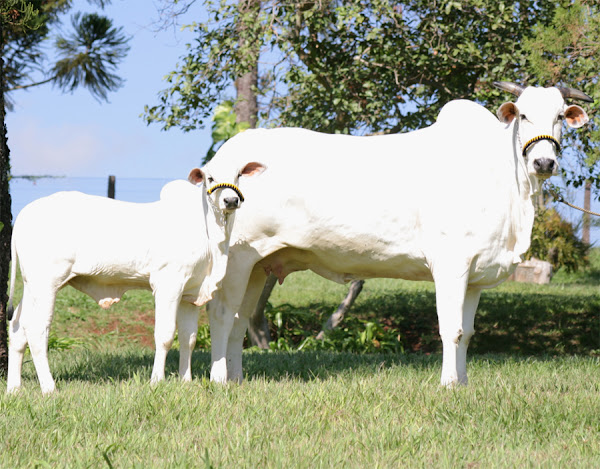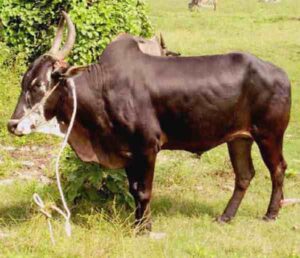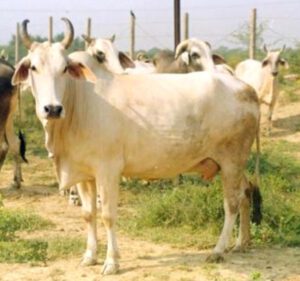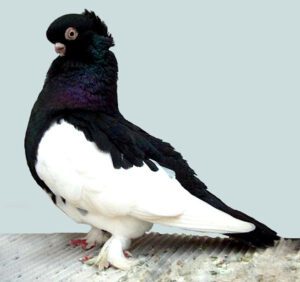The Nelore cattle (also called Nellore cattle) are a very beautiful breed of domestic cattle. They have great dissimilarities to the Bos taurus species, and are of the Bos indicus or Zebu species.
The Nelore cattle actually originated from the Ongole cattle which were originally brought to Brazil from India. The breed was named after the Nellore district in Andhra Pradesh state in India.
Currently, Brazil is the largest breeder of Nelore cattle. In the year of 1868, the first pair of Ongole cattle arrived in Brazil by ship at Salvador, Bahia. Manoel Ubelhart Lemgruber, from Rio de Janeiro Zoo.
Two more animals arrived there in 1878 from Hamburg Zoo. And 100 animals were imported from India in the 1960s.
And most of the Nelore cattle that are available today in Brazil were created from the lineages that were imported from India in the 1960s.
The Indubrasil or Indo-Brazilian was the favored breed of zebu in Brazil in the first decades of 20th century. But Nelore cattle become the primary and most favorite breed of beef cattle in Brazil from the 1960 onwards.
They became highly popular mainly because of their heat-resistance, hardiness and because it thrives on poor/low quality forage.
Today more than 80% of beef cattle in Brazil are either purebred or hybrid Nelore. And the breed was exported to many other countries such as Argentina, United States, Mexico, Paraguay, Central America, Venezuela and many other countries.
The Nelore herdbook was founded in 1875. Read more information about the breed below.
Nelore Cattle Characteristics
The Nelore cattle are medium sized animals. Their most distinctive characteristic is the presence of a prominent ‘hump’ behind their neck. But there many other differences between the Nelore and the European cattle breeds.
Nelore cattle are generally of white color with a black skin, tail and muzzle. They have comparatively long legs than other cattle breeds which help them walk in water when grazing. They are usually horned, and a naturally polled strain is also available. They have short ears, and their ears are probably shortest of most Bos indicus types.
Nelore bulls have short sheaths, and the cows have small udders and short teats. Average body weight of the Nelore cows is around 450 kg. And the bulls on average weight up to 500 kg. [1]

Uses
The Nelore cattle are mainly used for meat production in Brazil. They are also a popular beef breed in some other countries. They are also good for draught purposes.
Special Notes
Nelore cattle are noted and well known for their hardiness, easy calving, heat-resistance and capability of thriving on poor quality forage. They can adapt almost all climates except very cold climates. They have natural resistance to various parasites and diseases, and are very resistant to high temperatures.
Nelore cows have a long and prolific reproductive life, pronounced mothering ability, and plenty of milk for their calves. The calves are very alert with an active behavior.
These animals are also noted for their efficiency of converting poor quality forages into high quality beef. They can also withstand long periods without water and they are highly resistant to bloating.
Today the breed is used for producing very high quality beef in Brazil and many other countries. However, review full breed profile of this breed in the chart below.
| Breed Name | Nelore |
| Other Name | Nellore |
| Breed Purpose | Mainly meat |
| Special Notes | Strong, hardy, fertile, resistance to diseases, tall |
| Breed Size | Medium |
| Bulls | Up to 500 kg |
| Cows | Around 450 kg |
| Climate Tolerance | All Climates |
| Coat Color | Mainly white |
| Horned | Yes/Polled |
| Milk Yield | Average |
| Rarity | Common |
| Country/Place of Origin | India |






